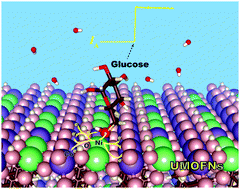The synergistic effect of Co/Ni in ultrathin metal–organic framework nanosheets for the prominent optimization of non-enzymatic electrochemical glucose detection†
Abstract
Hybrid metal compounds have been paid increasing attention for the development of electroanalysis materials due to the specific collaboration interaction and synergy effect of metal elements. Herein, a series of ultrathin Ni/Co bimetallic metal–organic-framework nanosheets (UMOFNs) with different metal ratios were investigated as high-performance electroanalysis materials for non-enzymatic glucose electrochemical sensing. The synergistic effect between Ni/Co endowed UMOFNs with not only the unique electrochemical behavior that prompts the sensing-related electrochemical oxidation at a low applied potential, but also the enhanced affinity to glucose; also, they facilitated the electron transfer involving the analyte. The UMOFN composite with an elaborately adjusted Co/Ni ratio exhibits an extremely outstanding glucose sensing performance, including high sensitivity (2086.7 μA mM−1 cm−2), wide linear range (0.1 μM–1.4 mM), low detection limit (0.047 μM), and excellent selectivity. It can also be used for the detection of glucose in actual human serum samples with an accuracy of 90.1%, demonstrating a good application prospect of the non-enzymatic electrochemical glucose detection.



 Please wait while we load your content...
Please wait while we load your content...